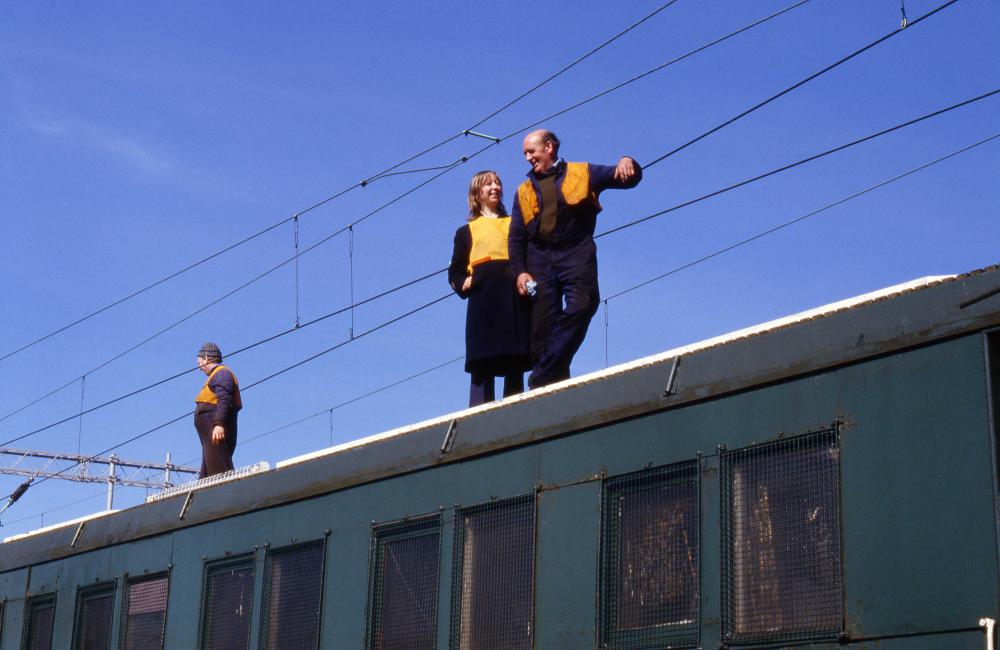Wigan Album
Railways
4 Comments
Photo: Mick Langton
Item #: 15580
Nice one Mick. There's no mistaking that shiny bald dome of Mick O'Neils, your lucky the sun was in the right place or else the camera would have been blinded by the intensity of the light!. This looks like the No. 2 train which more often that not spent it's life on the Liverpool Lines, wheras the No. 1 train was almost exclusively at work on the WCML. The No. 2 train was not as big nor as sophisticated as the No. 1 train which is visible in Tommy Sutch's picture Item No. 15575. Thanks Mick it is great to see this, and if you have any more lets get em up on the board.
Obviously a well respected gentleman shown here. I wouldn't lean on that cable even with the power off for a gold pig. Always made me wonder, so many thousand volts running through them things, but railway workers roam the tracks going about their day to day, even though that electricity jumps, not to mention 100mph trains shooting past you... dangerous job, highly commend those who do it.
One question, how the "L" would you know when the live cables are switch off, before work is carried out.
Well Tom the principles are really the same as any other electrical circuit and therefore no different to the domestic circuits in your own home; albeit that the kit used to make it safe is a little larger than the stuff the average spark will use at home. He will first isolate the supply by removing the fuse or fuses that feed the circuit, he will then test that the circuit is dead and ensure that it cannot be re-energised by retaining the fuse in his possession whilst the work takes place. In just the same way, the railway Nominated Person which is the grade of staff certificated (or certified depending on your point of view of course!) will arrange to have all sources of supply switched off to the circuit/s in question via the electric control operator. This can be done remotely or when necessary by local staff on site under instruction of the ECO. Once it is switched off the necessary paperwork is issued to the Nominated Person, who is then allowed to test the OHL equipment to be worked on to verify that it is indeed "dead" (poor choice of word I know, but that is the industry norm!), lastly the Nominated Person will take steps to prevent it being accidentally re-energised again. Since he cannot physically remove the fuses, he will apply some short circuiting devices called local earths to the OHL equipment using insulated tools. Finally, a Permit will be issued to the man in charge of doing the work which will clearly state the safe working limits for the work. Like any process it perhaps sounds a little complicated, but once you have done it for a while it does become second nature. The “ABC” procedure was a brand new procedure by the way designed by BR for the Euston/Manchester/Liverpool electrification scheme, arising out of the 1955 modernisation plan, which was the first 25,000 volt electrification in this country. Copied I regret to say, off the French!!
What fun I had with the trainees when they came to attend the training school at Wigan for ten days to learn the essentials of Nominated Person duties. My parting shot would always be when they had turned up on day ten i.e. the final day of the course and were generally beginning to feel quite comfortable with what they were taking on was ... "Now don't forget, when you have issued the Permit to work to the man in charge, he is perfectly entitled to turn to you and say "You first kid" i.e. you go and touch the bl**y stuff and prove its dead for me"!!
Well you should have seen the faces drop bless 'em, and in some cases faces that were quite a healthy colour at the start became quite a pale colour for some reason!! I will have a look for a few pictures illustrating the tools and equipment described above.